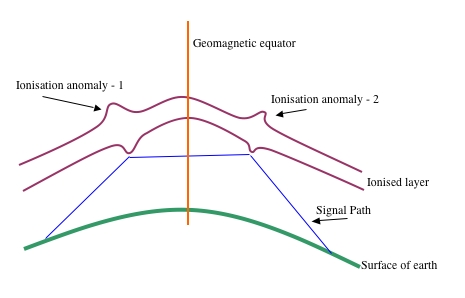Trans-Equatorial Propagation: Difference between revisions
mNo edit summary |
(added mor info and diagram of afternoon tep) |
||
| Line 1: | Line 1: | ||
Related wiki pages[[Bands]], [[Propagation]], [[Aurora]], [[Tropospheric ducting]], [[Lightning scatter]], [[Meteor scatter]] | Related wiki pages: [[Bands]], [[Propagation]], [[Aurora]], [[Tropospheric ducting]], [[Lightning scatter]], [[Meteor scatter]] | ||
Simplified ionospheric models portray the ionosphere as a series of horizntal layers that vary with time, location and sunspot activity. The real ionosphere is much more complex than this, particularly in in equatorial and polar regions. | Simplified ionospheric models portray the ionosphere as a series of horizntal layers that vary with time, location and sunspot activity. The real ionosphere is much more complex than this, particularly in in equatorial and polar regions. | ||
| Line 15: | Line 15: | ||
* those occuring during late afternoon and early evening, and usually over maximum distances of around 6000km. Contacts were restricted to the low VHF bands ([[6 metres]] for hams in most countries) | * those occuring during late afternoon and early evening, and usually over maximum distances of around 6000km. Contacts were restricted to the low VHF bands ([[6 metres]] for hams in most countries) | ||
* those occuring around 1900 to 2300 local time, with workable contacts being made on 144MHZ([[ 2 metres]]) and sometimes on 432MHz ([[70 centimetres]]) | * those occuring around 1900 to 2300 local time, with workable contacts being made on 144MHZ([[ 2 metres]]) and sometimes on 432MHz ([[70 centimetres]]) | ||
==Why does TEP occur over the Equator?== | |||
There are three general "zones" in the atmosphere of the Earth, Polar, Temperate and Equatorial. In terms of density, it has been found that equatorial ionosphereic areas are more dense than those over polar regions. This affects useable requencies within those regions. perhaps because they are at the "exteremes" of the earth in terms of their exposure to the effects of the sun, the polar and equatorial regions are subject to various unusual and unexpected variations in ionospheric conditions - thes eoften occuring in the F-Layer. | |||
Perhaps the most interesting of these effects is known as the "equatorial anomoly". This occurs where a high electron concentration is found on each side of the magnetic equator, and is usually seen in the region of 10 to 20 degrees latitude. | |||
The afternoon TEP is believed to occur when a signal is reflected first by an anomoly on one side of the equator and then again by another anomoly on the other side. | |||
[[Image:Vk4yeh_TEP_1.jpg | 500px]] | |||
Revision as of 01:31, 15 August 2008
Related wiki pages: Bands, Propagation, Aurora, Tropospheric ducting, Lightning scatter, Meteor scatter
Simplified ionospheric models portray the ionosphere as a series of horizntal layers that vary with time, location and sunspot activity. The real ionosphere is much more complex than this, particularly in in equatorial and polar regions.
What is Trans-Equatorial Propagation (TEP)?
Historically, the effect was first noticed in the 1940's by both military and amateur operators who discovered that it is possible to communicate in the VHF band over intercontinental distances during times of high sunspot activity.
The first organised and therefore relatively large scale TEP communications occurred during 1957-1958 in the peak of sunspot cycle 19. Sunspot peaks in 1970 (cycle 20) and 1977 (cycle 21) expanded our knowledge of thei phenomenon.
When does TEP occur?
Two distinct types of TEP have been identified:
- those occuring during late afternoon and early evening, and usually over maximum distances of around 6000km. Contacts were restricted to the low VHF bands (6 metres for hams in most countries)
- those occuring around 1900 to 2300 local time, with workable contacts being made on 144MHZ(2 metres) and sometimes on 432MHz (70 centimetres)
Why does TEP occur over the Equator?
There are three general "zones" in the atmosphere of the Earth, Polar, Temperate and Equatorial. In terms of density, it has been found that equatorial ionosphereic areas are more dense than those over polar regions. This affects useable requencies within those regions. perhaps because they are at the "exteremes" of the earth in terms of their exposure to the effects of the sun, the polar and equatorial regions are subject to various unusual and unexpected variations in ionospheric conditions - thes eoften occuring in the F-Layer.
Perhaps the most interesting of these effects is known as the "equatorial anomoly". This occurs where a high electron concentration is found on each side of the magnetic equator, and is usually seen in the region of 10 to 20 degrees latitude.
The afternoon TEP is believed to occur when a signal is reflected first by an anomoly on one side of the equator and then again by another anomoly on the other side.
